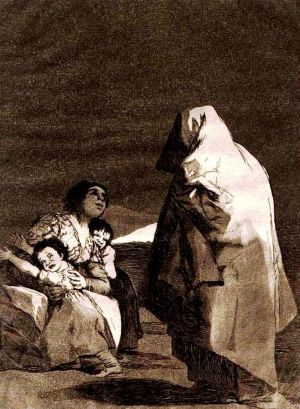(New page: The '''cucuy''' or '''el cucuy''' is the boogeyman of Latin American cultures. ==Etymology== The cucuy is known by different names to different people in Latin America, and even among La...) |
|||
| (2 intermediate revisions by the same user not shown) | |||
| Line 1: | Line 1: | ||
[[Image:Que viene el coco.jpg|thumb|right|Que Viene el Coco, (1799) by Goya]] | |||
The '''cucuy''' or '''el cucuy''' is the boogeyman of Latin American cultures. | The '''cucuy''' or '''el cucuy''' is the boogeyman of Latin American cultures. | ||
==Etymology== | ==Etymology== | ||
The | The myth of the coco originated in Portugal and Galicia. During the Portuguese and Spanish colonization of Latin America, the legend of the Cuco was spread to countries such as Mexico, Argentina and Chile. In the Mexican-American community the creature is known as ''El cucuy''. Other names include '''coco, cocu, cuco, chucho''' and '''chamuco'''. | ||
In Northern New Mexico and Southern Colorado, where there is a large Hispanic population, el cuco is referred to with its anglicized name, the '''Coco Man'''. | |||
According to the Real Academia Española the word ''coco'' derives from the Portuguese language, and referred to a ghost with a pumpkin head. The word coco is used in coloquial speech to mean the human head or skull in Portuguese and Spanish. The name coco could have its origins in the old Celtic word *kokk– meaning ''red''. | |||
==Description== | ==Description== | ||
The cucuy has no specific appearance, but rather is the subject of an irrational fear. However, some describe it as a small humanoid with glowing red eyes (alien-like). | The cucuy has no specific appearance, but rather is the subject of an irrational fear. However, some describe it as a small humanoid with glowing red eyes (alien-like). | ||
In Brazilian folklore, the typical monster sung in children rhymes is [[Cuca]], pictured as a female humanoid alligator from Portuguese ''coca'', a dragon. | |||
==Behavior== | ==Behavior== | ||
Like the bogeyman, el cucuy may hide in a closet or under the bed, or he may come out of the dark to terrorize a child. His name may be whispered to a child by parents to frighten the child into staying close by and behaving well. “Portate bien o te lleva el cucuy,” a parent may say. “Behave, or the cucuy will get you.” | Like the bogeyman, el cucuy may hide in a closet or under the bed, or he may come out of the dark to terrorize a child. His name may be whispered to a child by parents to frighten the child into staying close by and behaving well. “Portate bien o te lleva el cucuy,” a parent may say. “Behave, or the cucuy will get you.” | ||
Parents sing lullabies or tell rhymes to the children warning them that if they don't sleep, ''el Coco'' will come and get them. | |||
| Line 21: | Line 33: | ||
==See also== | ==See also== | ||
*[[ | *El [[Cuco]] | ||
*[[Cuca]] | *[[Cuca]] | ||
[[Category:South American and Mesoamerican mythology]] | [[Category:South American and Mesoamerican mythology]] | ||
[[Category: | [[Category:Bogeymen]] | ||
Latest revision as of 18:31, 15 March 2011
The cucuy or el cucuy is the boogeyman of Latin American cultures.
Etymology
The myth of the coco originated in Portugal and Galicia. During the Portuguese and Spanish colonization of Latin America, the legend of the Cuco was spread to countries such as Mexico, Argentina and Chile. In the Mexican-American community the creature is known as El cucuy. Other names include coco, cocu, cuco, chucho and chamuco.
In Northern New Mexico and Southern Colorado, where there is a large Hispanic population, el cuco is referred to with its anglicized name, the Coco Man.
According to the Real Academia Española the word coco derives from the Portuguese language, and referred to a ghost with a pumpkin head. The word coco is used in coloquial speech to mean the human head or skull in Portuguese and Spanish. The name coco could have its origins in the old Celtic word *kokk– meaning red.
Description
The cucuy has no specific appearance, but rather is the subject of an irrational fear. However, some describe it as a small humanoid with glowing red eyes (alien-like).
In Brazilian folklore, the typical monster sung in children rhymes is Cuca, pictured as a female humanoid alligator from Portuguese coca, a dragon.
Behavior
Like the bogeyman, el cucuy may hide in a closet or under the bed, or he may come out of the dark to terrorize a child. His name may be whispered to a child by parents to frighten the child into staying close by and behaving well. “Portate bien o te lleva el cucuy,” a parent may say. “Behave, or the cucuy will get you.”
Parents sing lullabies or tell rhymes to the children warning them that if they don't sleep, el Coco will come and get them.
Art/Fiction
- Danny Trejo's mercenary character Cucuy in the movie Once Upon A Time In Mexico is named after the boogeyman.
- Hard rock band Coal Chamber recorded a song named El Cu Cuy, available on the album Coal Chamber.
- Ska-Punk band Voodoo Glow Skulls composed a song named El Coo Cooi, present in the album Firme, in both spanish and english versions.
- Claudia Galindo, A school teacher, wrote two children's books titled Do you know the cucuy and Its Bedtime Cucuy.
- George Lopez has mentioned the Cucuy in more than one of his comedy shows. Stating "if my abuela wants to come live with me, I'll put her in the Cucuy room."
- El Cucuy is often mentioned in the comic strip Baldo.

